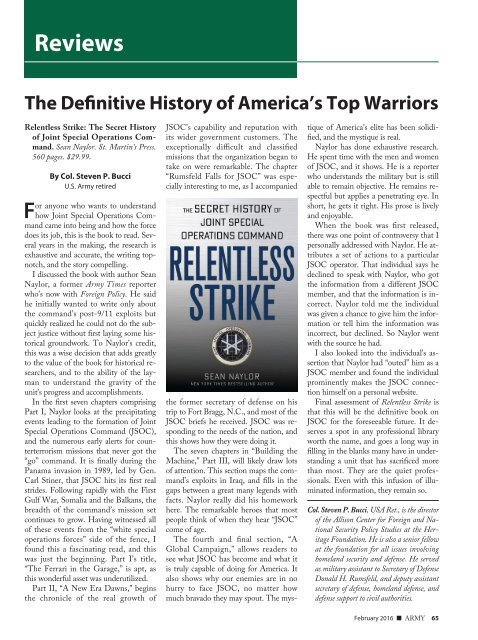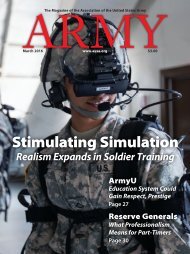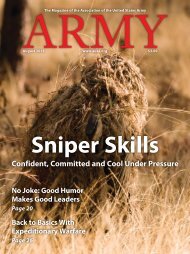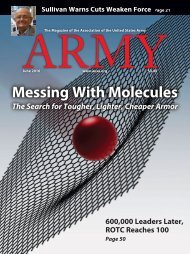Army - Kicking Tires On Jltv
Create successful ePaper yourself
Turn your PDF publications into a flip-book with our unique Google optimized e-Paper software.
Reviews<br />
The Definitive History of America’s Top Warriors<br />
Relentless Strike: The Secret History<br />
of Joint Special Operations Command.<br />
Sean Naylor. St. Martin’s Press.<br />
560 pages. $29.99.<br />
By Col. Steven P. Bucci<br />
U.S. <strong>Army</strong> retired<br />
For anyone who wants to understand<br />
how Joint Special Operations Command<br />
came into being and how the force<br />
does its job, this is the book to read. Several<br />
years in the making, the research is<br />
exhaustive and accurate, the writing topnotch,<br />
and the story compelling.<br />
I discussed the book with author Sean<br />
Naylor, a former <strong>Army</strong> Times reporter<br />
who’s now with Foreign Policy. He said<br />
he initially wanted to write only about<br />
the command’s post-9/11 exploits but<br />
quickly realized he could not do the subject<br />
justice without first laying some historical<br />
groundwork. To Naylor’s credit,<br />
this was a wise decision that adds greatly<br />
to the value of the book for historical researchers,<br />
and to the ability of the layman<br />
to understand the gravity of the<br />
unit’s progress and accomplishments.<br />
In the first seven chapters comprising<br />
Part I, Naylor looks at the precipitating<br />
events leading to the formation of Joint<br />
Special Operations Command (JSOC),<br />
and the numerous early alerts for counterterrorism<br />
missions that never got the<br />
“go” command. It is finally during the<br />
Panama invasion in 1989, led by Gen.<br />
Carl Stiner, that JSOC hits its first real<br />
strides. Following rapidly with the First<br />
Gulf War, Somalia and the Balkans, the<br />
breadth of the command’s mission set<br />
continues to grow. Having witnessed all<br />
of these events from the “white special<br />
operations forces” side of the fence, I<br />
found this a fascinating read, and this<br />
was just the beginning. Part I’s title,<br />
“The Ferrari in the Garage,” is apt, as<br />
this wonderful asset was underutilized.<br />
Part II, “A New Era Dawns,” begins<br />
the chronicle of the real growth of<br />
JSOC’s capability and reputation with<br />
its wider government customers. The<br />
exceptionally difficult and classified<br />
missions that the organization began to<br />
take on were remarkable. The chapter<br />
“Rumsfeld Falls for JSOC” was especially<br />
interesting to me, as I accompanied<br />
the former secretary of defense on his<br />
trip to Fort Bragg, N.C., and most of the<br />
JSOC briefs he received. JSOC was responding<br />
to the needs of the nation, and<br />
this shows how they were doing it.<br />
The seven chapters in “Building the<br />
Machine,” Part III, will likely draw lots<br />
of attention. This section maps the command’s<br />
exploits in Iraq, and fills in the<br />
gaps between a great many legends with<br />
facts. Naylor really did his homework<br />
here. The remarkable heroes that most<br />
people think of when they hear “JSOC”<br />
come of age.<br />
The fourth and final section, “A<br />
Global Campaign,” allows readers to<br />
see what JSOC has become and what it<br />
is truly capable of doing for America. It<br />
also shows why our enemies are in no<br />
hurry to face JSOC, no matter how<br />
much bravado they may spout. The mystique<br />
of America’s elite has been solidified,<br />
and the mystique is real.<br />
Naylor has done exhaustive research.<br />
He spent time with the men and women<br />
of JSOC, and it shows. He is a reporter<br />
who understands the military but is still<br />
able to remain objective. He remains respectful<br />
but applies a penetrating eye. In<br />
short, he gets it right. His prose is lively<br />
and enjoyable.<br />
When the book was first released,<br />
there was one point of controversy that I<br />
personally addressed with Naylor. He attributes<br />
a set of actions to a particular<br />
JSOC operator. That individual says he<br />
declined to speak with Naylor, who got<br />
the information from a different JSOC<br />
member, and that the information is incorrect.<br />
Naylor told me the individual<br />
was given a chance to give him the information<br />
or tell him the information was<br />
incorrect, but declined. So Naylor went<br />
with the source he had.<br />
I also looked into the individual’s assertion<br />
that Naylor had “outed” him as a<br />
JSOC member and found the individual<br />
prominently makes the JSOC connection<br />
himself on a personal website.<br />
Final assessment of Relentless Strike is<br />
that this will be the definitive book on<br />
JSOC for the foreseeable future. It deserves<br />
a spot in any professional library<br />
worth the name, and goes a long way in<br />
filling in the blanks many have in understanding<br />
a unit that has sacrificed more<br />
than most. They are the quiet professionals.<br />
Even with this infusion of illuminated<br />
information, they remain so.<br />
Col. Steven P. Bucci, USA Ret., is the director<br />
of the Allison Center for Foreign and National<br />
Security Policy Studies at the Heritage<br />
Foundation. He is also a senior fellow<br />
at the foundation for all issues involving<br />
homeland security and defense. He served<br />
as military assistant to Secretary of Defense<br />
Donald H. Rumsfeld, and deputy assistant<br />
secretary of defense, homeland defense, and<br />
defense support to civil authorities.<br />
February 2016 ■ ARMY 65

















